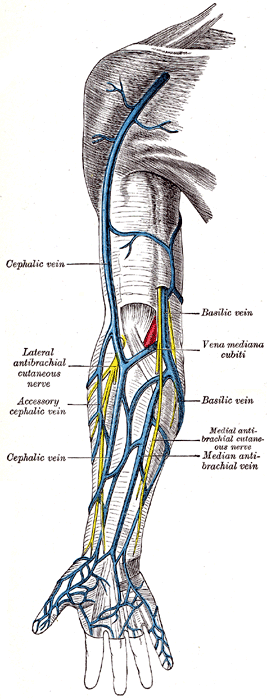Median cubital vein
The median cubital vein is a superficial vein of the upper limb. It is commonly used for venipuncture (taking blood) and is located in the antecubital fossa, which is the triangular area on the anterior view of the elbow.
Anatomy[edit | edit source]
The median cubital vein is a prominent vein that connects the cephalic vein and the basilic vein. It is typically found superficial to the bicipital aponeurosis, which is a broad, flat tendon of the biceps brachii muscle. The vein runs obliquely across the antecubital fossa, making it easily accessible for medical procedures.
Clinical Significance[edit | edit source]
The median cubital vein is often chosen for venipuncture due to its size and superficial location. It is less likely to move during needle insertion compared to other veins, making it a preferred site for drawing blood or administering intravenous therapy. Additionally, the median cubital vein is less likely to be surrounded by major nerves or arteries, reducing the risk of complications.
Variations[edit | edit source]
There can be variations in the anatomy of the median cubital vein. In some individuals, the vein may be absent, and the cephalic and basilic veins may connect through other superficial veins. These anatomical variations are important for healthcare professionals to consider during venipuncture to avoid complications.
Related Structures[edit | edit source]
See Also[edit | edit source]
References[edit | edit source]
External Links[edit | edit source]
Translate: - East Asian
中文,
日本,
한국어,
South Asian
हिन्दी,
தமிழ்,
తెలుగు,
Urdu,
ಕನ್ನಡ,
Southeast Asian
Indonesian,
Vietnamese,
Thai,
မြန်မာဘာသာ,
বাংলা
European
español,
Deutsch,
français,
Greek,
português do Brasil,
polski,
română,
русский,
Nederlands,
norsk,
svenska,
suomi,
Italian
Middle Eastern & African
عربى,
Turkish,
Persian,
Hebrew,
Afrikaans,
isiZulu,
Kiswahili,
Other
Bulgarian,
Hungarian,
Czech,
Swedish,
മലയാളം,
मराठी,
ਪੰਜਾਬੀ,
ગુજરાતી,
Portuguese,
Ukrainian
Navigation: Wellness - Encyclopedia - Health topics - Disease Index - Drugs - World Directory - Gray's Anatomy - Keto diet - Recipes
Search WikiMD
Ad.Tired of being Overweight? Try W8MD's physician weight loss program.
Semaglutide (Ozempic / Wegovy and Tirzepatide (Mounjaro / Zepbound) available.
Advertise on WikiMD
WikiMD is not a substitute for professional medical advice. See full disclaimer.
Credits:Most images are courtesy of Wikimedia commons, and templates Wikipedia, licensed under CC BY SA or similar.Contributors: Prab R. Tumpati, MD




